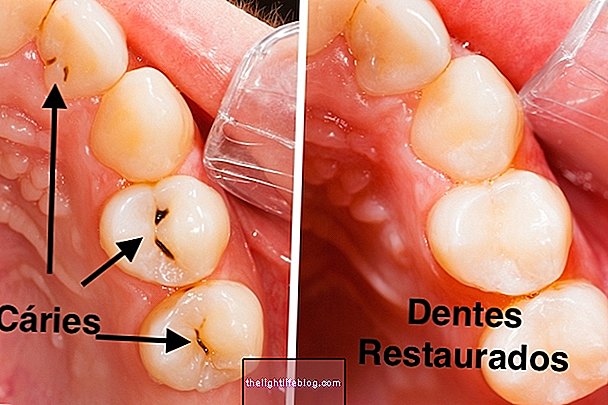Ultrasound, also known as ultrasound and ultrasound, is a diagnostic test used to visualize in real time any organ or tissue of the body. When the examination is performed with Doppler, the doctor can observe the blood flow of that region.
What is it for
Ultrasonography can be indicated for:
- Investigate abdominal pain, in the skinny or in the back;
- Diagnose pregnancy or evaluate fetal development;
- Diagnose diseases of the uterus, fallopian tubes, ovaries;
- Visualize the structures of muscles, joints, tendons, or
- To visualize any other structure of the human body.
This examination should be done in a laboratory, clinic or hospital, always under medical indication, to assist in the diagnosis or treatment of various situations.

How is it done?
Ultrasonography can be done with the patient lying on a stretcher, placing a thin layer of gel on the skin and positioning the transducer on top of this gel, sliding the device through the skin. This device will generate images that can be viewed on a computer and should be analyzed by the doctor.
After finishing the exam the doctor removes the gel with a paper towel and the person can go home. The exam does not cause pain or discomfort, it is easily accessible and is not usually an expensive exam, being covered by several health plans, although it can also be performed by the SUS.
Main types of ultrasound
Morphological ultrasonography
This is a special type of ultrasound that should be performed during pregnancy, between 20 and 24 weeks of gestation, to see if the baby is developing properly or if it has any malformations, such as Down Syndrome, myelomeningocele, anencephaly, hydrocephalus or congenital heart defects.
The duration of the exam varies from 20 to 40 minutes and this test is indicated for all pregnant women.
- Price : varies between 100 and 200 reais depending on the region.
- How it is done : the doctor will put a gel in the belly of the pregnant woman and pass a device throughout the uterine region. The device will generate images that can be viewed on the computer. Learn more details of the morphological ultrasound.

3D and 4D Ultrasound
This is a type of examination that allows a better visualization of the structure to be studied, giving a more real aspect. The ultrasound in 4D besides allowing a good observation of the baby still inside the belly of the mother, manages to capture its movements in real time.
They are particularly suitable for visualization of the fetus and can be performed from the 3rd month of gestation, but better images are obtained from the 6th month of pregnancy. Learn more about 3D and 4D Ultrasound.
- Price: 3D ultrasound costs from 100 to 250 reais, and 4D ultrasound can cost from 100 to 350 reais, depending on the region.
Ultrasound of the breast
On ultrasound of the breast the doctor can observe the appearance of a lump that can be felt in the palpation of the breast. This helps to identify whether it can be a benign nodule, suspected or breast cancer, and is still useful for evaluating the breast ducts, and to investigate the causes of breast pain, for example.
- How it is done: The woman should lie down without clothing and a bra while the doctor passes the equipment in any suspicious area. It is normal to take more time when there are cysts or nodules that need to be investigated. This test is not a substitute for mammography, but can be ordered by the doctor if the woman has large, firm breasts, which makes it difficult to perform the mammogram. Learn more details of the breast ultrasound.
Thyroid Ultrasonography
In the ultrasound of the medical thyroid it observes the size of this gland, its format and if it has some nodule. This examination may also be performed to guide a biopsy so that a small sample of the tissue is withdrawn in case of suspected cancer, for example.
- How it is done: The person should lie on his belly up, and then a gel is placed on the neck. The doctor will slide the device and see on the computer screen, how is the person's thyroid. It is normal during the examination to ask if it is the first time you take the exam or if there has been any change in previous exams so you can compare the results. Check out the symptoms that may indicate thyroid cancer.

Pelvic Ultrasonography
This test is indicated to visualize structures such as uterus, ovaries and blood vessels of this region, and may be necessary to diagnose endometriosis, for example. It can be performed by placing the transducer in the upper part of the belly or inside the vagina, and in the latter case it is called transvaginal ultrasonography. Learn details of transvaginal ultrasound.
Abdominal Ultrasonography
Abdominal ultrasound is used to investigate pain in the abdomen, if there are any fluids in the abdomen, or to evaluate organs such as the liver, kidneys, presence of masses and in case of trauma or blows to the belly. In addition to being useful in case of evaluation of the kidneys and urinary tract, for example.
- How it is done: The doctor will indicate if you need to do some type of preparation before, but in the case of evaluation of the kidneys, urinary tract and bladder itself, a fast of 6 hours is recommended before the exam, and the examination must be performed with a full bladder. That is why children 3 to 10 years old should drink 2 to 4 glasses of water, adolescents and adults should drink 5 to 10 glasses of water up to 1 hour before the exam, without being able to pee before the exam.























